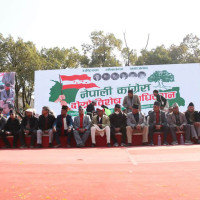- Wednesday, 14 January 2026
Native nursery rhymes losing space
Kathmandu, June 3: “Pani paryo, asina jharyo,
Daiko rumal bhauju lai man paryo”
(It rains, it hails/The sister-in-law likes the brother’s handkerchief)
No sooner would a drop of water fall from the sky than Nitu Basnet would yell out this song.
Whether at school or at home or at a relative’s house, if it rained, Basnet would jump up from wherever she was sitting and would sing this song with a mix of energy and enthusiasm that she could only muster as a child.
“It was almost involuntary,” the now 35-year-old Basnet recalled. “And it was not just me. All the children in my family and locality would chant this rhyme.”
Her husband Ashwin, 38, also recounted how he used to sing the cat song as a child.
“Meow meow biralo, yeta tira aau,
Mero nana kaatidine musa maari khau”
(Meow meow, oh cat, come here!
Kill and eat the rat that cuts my clothes)
“It was an unfailing means of entertainment for us,” he said. “We used to sing and laugh among ourselves.”
The Basnets’ only son, though, can sing neither of these songs fluently. The six-year-old Rizwan told The Rising Nepal that he can sing English rhymes better than Nepali ones – Baa Baa Black Sheep and Rock-A-Bye Baby being his favourites.
Similarly, Kiran Karki has been trying to teach her four-year-old daughter Aaradhya the rhyme Gham Pani, Gham Pani, Syaalko Bihe (When it rains while the sun shines, the jackal gets married) for three months now but in vain/to no avail. “She enjoys singing Twinkle Twinkle Little Stars more,” she said.
Nursery rhymes – simple songs or poems for children – play a huge role in the growth and holistic development of children, experts say. They introduce language to kids and impart life lessons. But like Rizwan and Aaradhya, children these days, especially those living in urban areas, are more familiar with English rhymes than the native ones.
Several kindergarten teachers The Rising Nepal talked to said that the pre-schoolers they taught were more comfortable singing in English than their mother tongues. “Perhaps this is because of their exposure, or lack thereof, to traditional jingles,” teacher Pramisa Khadka said, noting the impact of YouTube in particular.
“Most of the songs and poems available on YouTube are in English. The few that are in Nepali and other national languages are not as attractive and colourful and do not grab kids’ attention,” Khadka, a mother of two, son aged eight and daughter aged three, said.
And this is a cause for concern, according to early child education and development specialist Kunti Rana. Nursery rhymes help enhance children’s ability to grasp concepts and linguistic traits, she said.
“The verses have morals and are made within specific social contexts,” Rana, who is also the executive director of Seto Gurans National Child Development Services, said. “The children learn the most from them when they are in their native tongue.”
Pramod Pradhan, writer of children’s literature and author of the historical survey ‘Nepali Balsahitya Ko Itihas’ (History of Nepali Children’s Literature), also shared a similar opinion. “Children’s songs teach language, rhythm and alliteration.
They enrich vocabulary and develop societal awareness,” he said. “Losing them would mean losing a part of our culture.”
Pradhan stated that local governments specifically needed to formulate a plan to conserve these rhymes and needed to do it fast. “The grandparents of today are perhaps the last generation who hold sound knowledge of these songs. So, we need to work while they are still alive because once they die, we will lose many of them forever.” It is not that the children do not learn from foreign-language songs but these learnings do not stay as long or make as much of an impact as their first languages. Rana compared this to rote learning.








-square-thumb.jpg)





